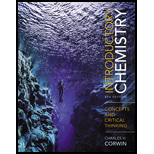
Concept explainers
(a)
Interpretation:
The diagram of the substance is of an atom, a molecule, or a formula unit is to be identified.
Concept introduction:
An atom is the smallest unit of a matter. A molecule consists of two or more atoms of same or different elements bonded together by covalent bonds. It consists of non-metals. A formula unit consists of two or more elements held together by ionic bonds. It consists of metals.
(b)
Interpretation:
The diagram of the substance is of an atom, a molecule, or a formula unit is to be identified.
Concept introduction:
An atom is the smallest unit of a matter. A molecule consists of two or more atoms of same or different elements bonded together by covalent bonds. It consists of non-metals. A formula unit consists of two or more elements held together by ionic bonds. It consists of metals.
(c)
Interpretation:
The diagram of the substance is of an atom, a molecule, or a formula unit is to be identified.
Concept introduction:
An atom is the smallest unit of a matter. A molecule consists of two or more atoms of same or different elements bonded together by covalent bonds. It consists of non-metals. A formula unit consists of two or more elements held together by ionic bonds. It consists of metals.
Want to see the full answer?
Check out a sample textbook solution
Chapter 12 Solutions
Introductory Chemistry: Concepts and Critical Thinking Plus MasteringChemistry with eText -- Access Card Package
- Provide the formula for each of the following binary ionic compounds. (a) cuprous phosphide (b) cobaltic sulfidearrow_forwardDistinguish between the terms in each of the following pairs, using specific examples.. (b) physical and chemical properties (c) atom and ion d) acid and base e) ionic and molecular compoundarrow_forwardProvide the formula for each of the following monoatomic anions: (a) fluoride ion (b) oxide ionarrow_forward
- Provide the formula for each of the following polyatomic ions. (a) chromate ion (b) dichromate ion (c) hydroxide ion (d) cyanide ionarrow_forwardWrite the formula for each of the following compounds containing a semimetal. (a) boron tribromide (b) trisilicon tetranitride (c) diarsenic trioxide (d) diantimony pentaoxidearrow_forwardGive the name and formula of an ionic compound involving only the elements in each pair that follows. WriteLewis symbols for the elements both before and afterchemical combination.(a) Chlorine and cesium (b) Calcium and astatine(c) Aluminum and sulfur (d) Potassium and telluriumarrow_forward
- Write a formula for each acid.(a) hydrofluoric acid (b) hydrocyanic acid(c) chlorous acidarrow_forwardGive the name and formula of an ionic compound involving only the elements in each pair that follows. WriteLewis symbols for the elements both before and afterchemical combination.(a) Gallium and bromine (b) Strontium and polonium(c) Magnesium and iodine (d) Lithium and seleniumarrow_forwardPlease explain alsoarrow_forward
- Use your knowledge of the correct number of covalent bonds to predict the formula for a simple compound formed between silicon and the following elements. (Enter NONE if no compound is likely to form.) (a) hydrogen chemPad Help (b) iodine chemPad Help (c) helium chemPad Help (d) seleniumarrow_forwardProvide the formula for each of the following binary ionic compounds. (a) stannic nitrite (b) ferrous acetatearrow_forwardUse your knowledge of the correct number of covalent bonds to predict the formula for a simple compound formed between bromine and the following elements. (Enter NONE if no compound is likely to form.) (a) phosphorus (b) carbon (c) nitrogen (d) hydrogenarrow_forward
 World of Chemistry, 3rd editionChemistryISBN:9781133109655Author:Steven S. Zumdahl, Susan L. Zumdahl, Donald J. DeCostePublisher:Brooks / Cole / Cengage LearningChemistry: Matter and ChangeChemistryISBN:9780078746376Author:Dinah Zike, Laurel Dingrando, Nicholas Hainen, Cheryl WistromPublisher:Glencoe/McGraw-Hill School Pub Co
World of Chemistry, 3rd editionChemistryISBN:9781133109655Author:Steven S. Zumdahl, Susan L. Zumdahl, Donald J. DeCostePublisher:Brooks / Cole / Cengage LearningChemistry: Matter and ChangeChemistryISBN:9780078746376Author:Dinah Zike, Laurel Dingrando, Nicholas Hainen, Cheryl WistromPublisher:Glencoe/McGraw-Hill School Pub Co Living By Chemistry: First Edition TextbookChemistryISBN:9781559539418Author:Angelica StacyPublisher:MAC HIGHER
Living By Chemistry: First Edition TextbookChemistryISBN:9781559539418Author:Angelica StacyPublisher:MAC HIGHER Introductory Chemistry: An Active Learning Approa...ChemistryISBN:9781305079250Author:Mark S. Cracolice, Ed PetersPublisher:Cengage Learning
Introductory Chemistry: An Active Learning Approa...ChemistryISBN:9781305079250Author:Mark S. Cracolice, Ed PetersPublisher:Cengage Learning World of ChemistryChemistryISBN:9780618562763Author:Steven S. ZumdahlPublisher:Houghton Mifflin College Div
World of ChemistryChemistryISBN:9780618562763Author:Steven S. ZumdahlPublisher:Houghton Mifflin College Div




